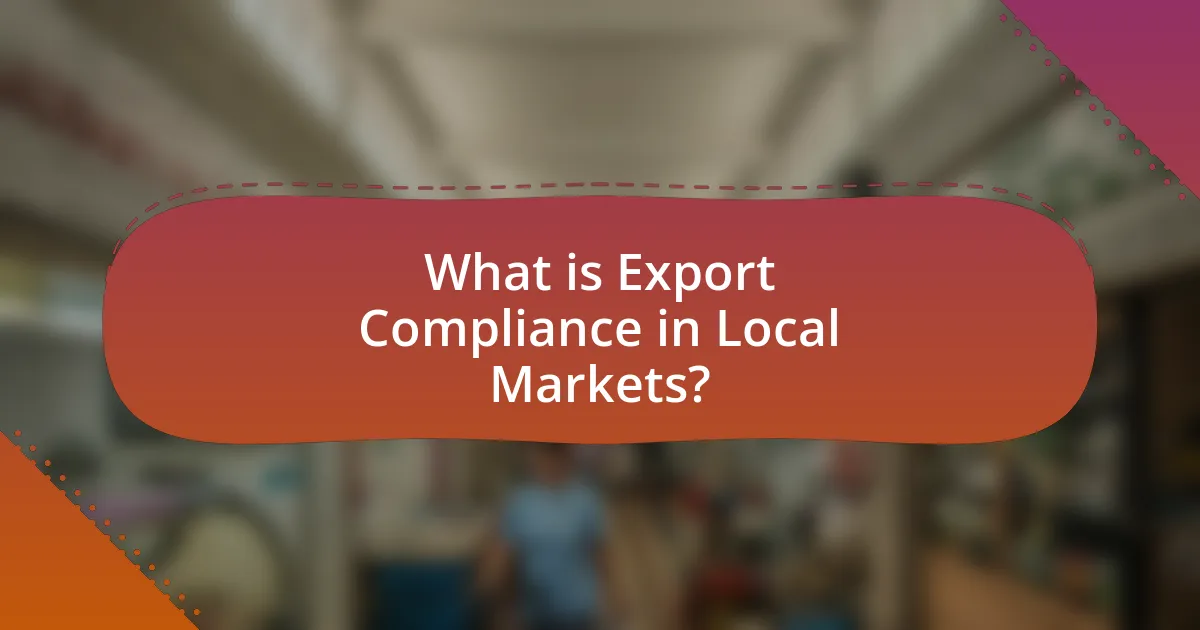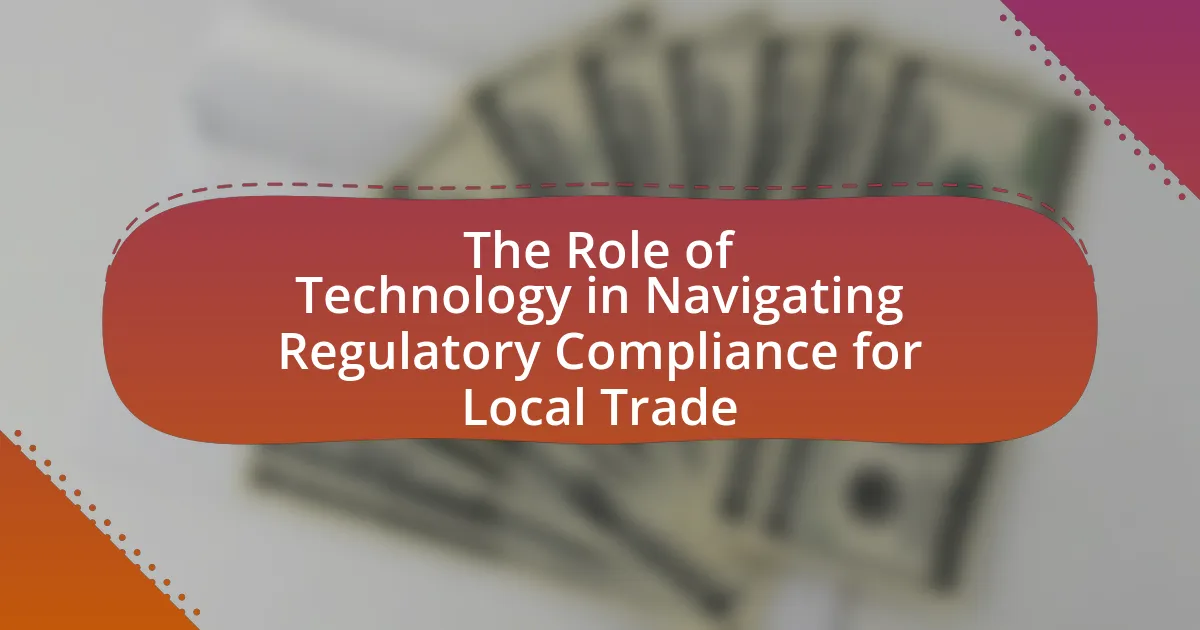Export compliance in local markets involves adhering to laws and regulations that govern the export of goods and services, ensuring businesses obtain necessary licenses and meet safety standards. This article outlines the importance of export compliance for businesses, highlighting the risks of non-compliance, including legal penalties and reputational damage. Key regulations such as the Export Administration Regulations (EAR) and International Traffic in Arms Regulations (ITAR) are discussed, along with the impact of international agreements on local markets. The article also addresses common challenges in navigating compliance, the role of technology, and best practices for developing effective compliance strategies.

What is Export Compliance in Local Markets?
Export compliance in local markets refers to the adherence to laws and regulations governing the export of goods and services from one country to another. This compliance ensures that businesses follow specific legal requirements, such as obtaining necessary licenses, adhering to trade restrictions, and ensuring that exported products meet safety and quality standards. For instance, the U.S. Export Administration Regulations (EAR) and the International Traffic in Arms Regulations (ITAR) set forth guidelines that companies must follow to avoid penalties and legal issues. Non-compliance can result in significant fines, loss of export privileges, and damage to a company’s reputation.
Why is Export Compliance important for businesses?
Export compliance is crucial for businesses because it ensures adherence to international trade laws and regulations, thereby mitigating legal risks and potential penalties. Non-compliance can lead to severe consequences, including hefty fines, loss of export privileges, and damage to a company’s reputation. For instance, the U.S. Bureau of Industry and Security reported that violations of export regulations can result in fines reaching millions of dollars, emphasizing the financial stakes involved. Furthermore, maintaining compliance fosters trust with partners and customers, as it demonstrates a commitment to ethical business practices and regulatory standards.
What are the potential risks of non-compliance?
The potential risks of non-compliance include legal penalties, financial losses, and reputational damage. Legal penalties can manifest as fines or sanctions imposed by regulatory authorities, which can reach millions of dollars depending on the severity of the violation. Financial losses may arise from disrupted business operations, loss of contracts, or increased scrutiny from regulators, leading to higher operational costs. Reputational damage can result in a loss of customer trust and market position, as stakeholders may view non-compliance as a sign of poor governance or risk management. For instance, a study by the International Compliance Association found that companies facing compliance issues often experience a 20% decline in customer loyalty.
How does compliance impact international trade relationships?
Compliance significantly impacts international trade relationships by establishing trust and facilitating smoother transactions between trading partners. When countries adhere to international trade regulations and standards, they reduce the risk of legal disputes and trade barriers, which fosters a more stable trading environment. For instance, compliance with the World Trade Organization’s agreements ensures that nations uphold fair trade practices, thereby enhancing cooperation and reducing tariffs. Furthermore, companies that demonstrate compliance with export controls and customs regulations are more likely to gain access to foreign markets, as they are viewed as reliable partners. This is evidenced by the fact that non-compliance can lead to sanctions or trade restrictions, which can severely disrupt trade flows and damage relationships.
What are the key regulations governing Export Compliance?
The key regulations governing Export Compliance include the Export Administration Regulations (EAR), the International Traffic in Arms Regulations (ITAR), and the Office of Foreign Assets Control (OFAC) regulations. The EAR, administered by the Bureau of Industry and Security, controls the export of dual-use goods and technologies, while ITAR, managed by the Directorate of Defense Trade Controls, regulates defense-related articles and services. OFAC regulations impose economic and trade sanctions against targeted foreign countries and regimes. These regulations are essential for ensuring that exports do not compromise national security or violate international agreements.
Which international agreements affect local markets?
International agreements that affect local markets include trade agreements such as the North American Free Trade Agreement (NAFTA), now replaced by the United States-Mexico-Canada Agreement (USMCA), and the European Union’s Common Market regulations. These agreements establish rules for trade, tariffs, and market access, directly influencing local economies by altering competitive dynamics and pricing structures. For instance, the USMCA aims to enhance trade among the U.S., Canada, and Mexico by reducing tariffs and fostering economic cooperation, which can lead to increased market opportunities for local businesses. Additionally, the World Trade Organization (WTO) agreements set global trade standards that member countries must adhere to, impacting local market regulations and practices.
How do local laws vary across different regions?
Local laws vary across different regions primarily due to differences in cultural, economic, and political contexts. For instance, regulations governing export compliance can differ significantly between the European Union, which has stringent data protection laws like the General Data Protection Regulation (GDPR), and the United States, where regulations may be more flexible and industry-specific. Additionally, local laws may reflect regional priorities, such as environmental protections in Scandinavian countries compared to less stringent regulations in some developing nations. These variations necessitate that businesses conducting international trade thoroughly research and understand the specific legal requirements of each region to ensure compliance and avoid penalties.
What are the common challenges in navigating Export Compliance?
Common challenges in navigating Export Compliance include understanding complex regulations, ensuring accurate classification of goods, and maintaining proper documentation. Regulations vary significantly across countries, making it difficult for businesses to stay compliant. For instance, the U.S. Export Administration Regulations (EAR) and International Traffic in Arms Regulations (ITAR) impose strict controls that require precise knowledge of export classifications. Additionally, misclassifying products can lead to severe penalties, including fines and loss of export privileges. Proper documentation is essential for compliance, yet many companies struggle with maintaining up-to-date records, which can result in compliance failures during audits. These challenges highlight the need for robust compliance programs and ongoing training to mitigate risks associated with export activities.
How can businesses identify compliance gaps?
Businesses can identify compliance gaps by conducting thorough audits of their current practices against regulatory requirements. This process involves reviewing internal policies, procedures, and documentation to ensure alignment with local and international laws governing export compliance. For instance, a study by the International Trade Administration highlights that regular compliance assessments can reveal discrepancies in documentation and reporting practices, which are critical for maintaining adherence to export regulations. Additionally, utilizing compliance management software can streamline the identification of gaps by automating the tracking of regulatory changes and compliance status, thereby enhancing overall compliance efforts.
What role does technology play in overcoming these challenges?
Technology plays a crucial role in overcoming challenges related to navigating export compliance in local markets by automating compliance processes and enhancing data accuracy. For instance, software solutions can streamline the documentation required for exports, ensuring that all necessary permits and regulations are met efficiently. According to a report by the International Trade Administration, companies utilizing compliance management software have seen a 30% reduction in compliance-related errors, which directly impacts their ability to operate in diverse markets. Additionally, technology enables real-time tracking of regulatory changes, allowing businesses to adapt quickly and maintain compliance, thereby reducing the risk of penalties and delays.

How can businesses ensure compliance in local markets?
Businesses can ensure compliance in local markets by conducting thorough research on local laws and regulations. This involves understanding specific legal requirements, such as licensing, taxation, and labor laws, which vary significantly across regions. For instance, a study by the World Bank indicates that businesses that actively engage in compliance training and local legal consultations reduce the risk of penalties by up to 30%. Additionally, establishing a local compliance team or partnering with local legal experts can provide ongoing support and updates on regulatory changes, further enhancing compliance efforts.
What steps should businesses take to develop a compliance strategy?
Businesses should take the following steps to develop a compliance strategy: first, they must conduct a comprehensive risk assessment to identify relevant regulations and compliance requirements specific to their industry and local markets. This assessment should include an analysis of export laws, trade agreements, and local regulations that impact their operations.
Next, businesses should establish clear policies and procedures that align with identified compliance requirements. These policies should be documented and communicated to all employees to ensure understanding and adherence.
Training programs should then be implemented to educate employees about compliance obligations and the importance of adhering to established policies. Regular training sessions help reinforce compliance culture within the organization.
Additionally, businesses should designate a compliance officer or team responsible for overseeing compliance efforts, monitoring changes in regulations, and ensuring ongoing adherence to compliance standards.
Finally, businesses should implement a system for regular audits and reviews of compliance practices to identify areas for improvement and ensure that the compliance strategy remains effective and up-to-date with evolving regulations. This systematic approach is essential for maintaining compliance and mitigating risks associated with non-compliance.
How can training and education improve compliance awareness?
Training and education can significantly improve compliance awareness by equipping individuals with the necessary knowledge and skills to understand and adhere to regulations. When employees receive targeted training on compliance requirements, they become more informed about legal obligations, potential risks, and the importance of following established protocols. Research indicates that organizations with comprehensive compliance training programs experience a 50% reduction in compliance violations, demonstrating the effectiveness of education in fostering a culture of compliance. Furthermore, ongoing education ensures that employees stay updated on changes in regulations, thereby enhancing their ability to navigate export compliance in local markets effectively.
What resources are available for businesses seeking compliance guidance?
Businesses seeking compliance guidance can access a variety of resources, including government websites, industry associations, and compliance consulting firms. Government websites, such as the U.S. Department of Commerce and the Bureau of Industry and Security, provide comprehensive regulations and guidelines for export compliance. Industry associations, like the Export Compliance Training Institute, offer training programs and resources tailored to specific sectors. Additionally, compliance consulting firms provide expert advice and tailored solutions to help businesses navigate complex compliance requirements. These resources collectively ensure that businesses remain informed and compliant with export regulations.
How can businesses monitor and adapt to changing regulations?
Businesses can monitor and adapt to changing regulations by implementing a systematic approach that includes regular compliance audits, subscribing to regulatory updates, and engaging with industry associations. Regular compliance audits allow businesses to assess their current practices against existing regulations, ensuring they remain compliant. Subscribing to regulatory updates from government agencies and legal firms provides timely information on changes in laws and regulations. Additionally, engaging with industry associations offers insights into best practices and collective experiences regarding regulatory changes, which can inform a business’s adaptation strategies. This multi-faceted approach ensures that businesses stay informed and can swiftly adjust their operations to comply with new regulations, thereby minimizing legal risks and maintaining operational integrity.
What tools can assist in tracking regulatory changes?
Regulatory tracking tools such as compliance management software, regulatory change management platforms, and specialized databases can assist in monitoring regulatory changes. Compliance management software like LogicGate and ComplyAdvantage provides real-time updates on regulatory changes relevant to specific industries. Regulatory change management platforms, such as Thomson Reuters Regulatory Intelligence, aggregate and analyze regulatory updates from various jurisdictions, ensuring businesses stay informed. Additionally, specialized databases like LexisNexis and Westlaw offer comprehensive legal research tools that include tracking capabilities for regulatory changes, making it easier for organizations to maintain compliance in local markets.
How often should compliance audits be conducted?
Compliance audits should be conducted at least annually. This frequency is recommended to ensure that organizations remain compliant with evolving regulations and standards, particularly in the context of export compliance, which can vary significantly across local markets. Annual audits allow for timely identification of potential compliance gaps and the implementation of corrective actions, thereby minimizing risks associated with non-compliance. Regular audits also align with best practices in risk management and regulatory adherence, as highlighted by the International Organization for Standardization (ISO), which emphasizes the importance of periodic reviews to maintain compliance and improve operational effectiveness.

What best practices can enhance Export Compliance efforts?
Implementing a robust export compliance program enhances export compliance efforts significantly. Key best practices include conducting regular training for employees on export regulations, which ensures that staff are aware of compliance requirements and updates. Additionally, establishing a comprehensive screening process for customers and transactions helps identify potential risks associated with exports. Utilizing technology, such as automated compliance software, can streamline the compliance process and reduce human error. Regular audits of export activities further reinforce adherence to regulations and identify areas for improvement. These practices collectively contribute to a stronger compliance framework, minimizing the risk of violations and penalties.
What are the key components of an effective compliance program?
The key components of an effective compliance program include a clear compliance policy, risk assessment, training and education, monitoring and auditing, reporting mechanisms, and enforcement and discipline. A clear compliance policy establishes the framework and expectations for compliance within the organization. Risk assessment identifies potential compliance risks specific to the local market, allowing for targeted strategies. Training and education ensure that employees understand compliance requirements and their roles in maintaining them. Monitoring and auditing provide ongoing evaluation of compliance practices, while reporting mechanisms encourage employees to report violations without fear of retaliation. Finally, enforcement and discipline ensure that violations are addressed consistently, reinforcing the importance of compliance. These components collectively contribute to a robust compliance program that mitigates risks and promotes adherence to regulations.
How can businesses foster a culture of compliance?
Businesses can foster a culture of compliance by implementing comprehensive training programs that educate employees on regulatory requirements and ethical standards. These training initiatives should be regularly updated to reflect changes in laws and regulations, ensuring that all staff members are aware of their responsibilities. Research indicates that organizations with robust compliance training see a 50% reduction in compliance violations, highlighting the effectiveness of such programs. Additionally, establishing clear communication channels for reporting compliance issues without fear of retaliation further reinforces a culture of accountability and transparency.
What role does communication play in compliance success?
Communication is essential for compliance success as it ensures that all stakeholders understand regulations and expectations. Effective communication facilitates the dissemination of compliance policies, training, and updates, which are crucial for adherence to legal requirements. For instance, organizations that implement regular training sessions and clear communication channels report a 30% increase in compliance adherence, according to a study by the Compliance and Ethics Institute. This highlights that transparent communication not only informs employees but also fosters a culture of accountability, ultimately leading to improved compliance outcomes.
What common pitfalls should businesses avoid in Export Compliance?
Businesses should avoid inadequate training of employees in export compliance, as this can lead to unintentional violations of regulations. Insufficient knowledge about export laws and procedures can result in costly fines and legal repercussions. Additionally, failing to conduct thorough due diligence on customers and end-users can expose businesses to risks associated with exporting to restricted entities or countries. Another common pitfall is neglecting to keep up with changes in export regulations, which can lead to non-compliance with current laws. Lastly, businesses often overlook the importance of maintaining accurate records of export transactions, which is essential for demonstrating compliance during audits or investigations.
How can businesses prevent misinterpretation of regulations?
Businesses can prevent misinterpretation of regulations by implementing comprehensive training programs for employees and establishing clear communication channels. Training ensures that staff understand the specific regulations relevant to their operations, reducing the likelihood of errors. For instance, a study by the Compliance, Governance and Oversight Council found that organizations with robust compliance training programs experience 50% fewer regulatory violations. Additionally, maintaining open lines of communication with regulatory bodies allows businesses to clarify any ambiguities in regulations, further minimizing misinterpretation.
What are the consequences of inadequate documentation?
Inadequate documentation can lead to severe consequences, including legal penalties, financial losses, and operational inefficiencies. Specifically, businesses may face fines or sanctions from regulatory authorities for non-compliance with export laws, which can amount to millions of dollars. Additionally, insufficient documentation can result in delays in shipments, causing disruptions in supply chains and loss of customer trust. A study by the International Trade Administration highlights that companies with poor documentation practices experience a 30% increase in compliance-related costs. Furthermore, inadequate records can hinder the ability to trace products, complicating recall processes and increasing liability risks.
What practical tips can help businesses navigate Export Compliance effectively?
To navigate Export Compliance effectively, businesses should implement a comprehensive compliance program that includes regular training for employees on export regulations, thorough documentation of all export transactions, and the use of compliance software to track and manage export activities. Regular training ensures that employees are aware of the latest regulations, as export laws can change frequently; for instance, the Bureau of Industry and Security (BIS) updates its regulations periodically, making ongoing education essential. Thorough documentation provides a clear audit trail, which is crucial for demonstrating compliance during inspections or audits by regulatory agencies. Utilizing compliance software can streamline the process of managing export licenses and screening against denied party lists, thereby reducing the risk of non-compliance. These practices collectively enhance a business’s ability to navigate the complexities of export compliance effectively.




